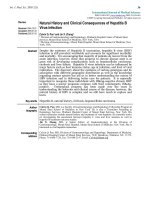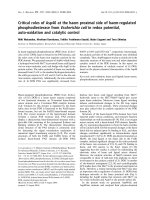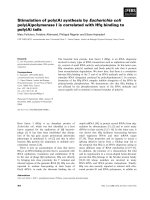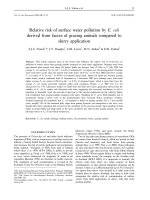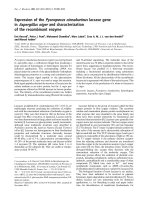Relative expression of TLR9 gene in natural sub-clinical and clinical cases of bovine mastitis caused by Escherichia coli
Bạn đang xem bản rút gọn của tài liệu. Xem và tải ngay bản đầy đủ của tài liệu tại đây (391.32 KB, 6 trang )
Int.J.Curr.Microbiol.App.Sci (2017) 6(5): 1753-1758
International Journal of Current Microbiology and Applied Sciences
ISSN: 2319-7706 Volume 6 Number 5 (2017) pp. 1753-1758
Journal homepage:
Original Research Article
/>
Relative Expression of TLR9 Gene in Natural Sub-clinical and Clinical Cases
of Bovine Mastitis caused by Escherichia coli
R. Lakshmi1*and K.K. Jayavardhanan2
1
Department of Veterinary Biochemistry, Rajiv Gandhi Institute of Veterinary
Education and Research, Puducherry - 605 009, India
2
Department of Veterinary Biochemistry, College of Veterinary and Animal Sciences,
Thrissur, Kerala – 680651, India
*Corresponding author
ABSTRACT
Keywords
TLR9,
Expression,
Mastitis and
E. coli
Article Info
Accepted:
17 April 2017
Available Online:
10 May 2017
Mastitis is an inflammatory condition of the mammary tissue resulting in several
physiological and metabolic changes, trauma, and more frequently it is caused by
contagious or environmental pathogenic microorganisms, including Gram-positive and
Gram-negative bacteria. Escherichia coli are most common infectious agents responsible
for sub-clinical and clinical mastitis in dairy forms. The first line of defense against
mammary bacterial infection was initiated by innate resistance of mammary gland. Tolllike receptors (TLRs) are a key family of innate immune proteins, serving as the principal
recognition site of pathogens and signalling functions, enabling the host to eliminate
pathogens. Hence, this study assessed the expression of an important TLR9 gene in
spontaneous bovine sub-clinical and clinical mastitis caused by E. coli. The total RNA was
isolated from milk somatic cells converted as cDNA using oligo (dT) primers. Relative
quantitation of mRNA of TLR9 was analysed by RT-qPCR system. The mRNA expression
of TLR9 gene in sub-clinical mastitis was higher (3.22 fold) than clinical case (1.09 fold)
when compared to normal bovine case. Relative difference in the expression of TLR9 gene
in sub-clinical and clinical mastitis was found to be significant (P ≤ 0.05). During subclinical stage of infection the expression of TLR9 gene was at high level, therefore most of
the sub-clinical mastitis subsided by itself without precipitating into clinical mastitis. TLR9
mediated signalling cascades will be fundamental to understand the host immune response
against bovine mastitis.
Introduction
Mastitis is one of the major endemic diseases
of dairy cattle and its prevalence is increasing
in parallel with the development of new high
milk producing breeds. Escherichia coli is a
gram-negative most common infectious
agents responsible for subclinical and clinical
mastitis in dairy forms (Bradley et al., 2007).
Innate resistance of mammary gland is one of
the first line of host defense against mammary
bacterial infection. Toll-like receptors (TLRs)
are a key family of innate immune proteins,
serving as the principal recognition site of
pathogens and signalling functions, enabling
the host to eliminate pathogens (Hallman et
al., 2001). Currently, 13 TLRs have been
identified in mammals (TLR1 to TLR13) of
which 10 TLRs are reported in cattle (Tabeta
et al., 2004; Roach et al., 2005). Of these,
1753
Int.J.Curr.Microbiol.App.Sci (2017) 6(5): 1753-1758
TLR9 is the main pathogen recognition
receptors (PRR), for bacteria and virus. TLR9
has been demonstrated as a receptor for
bacterial DNA comprising unmethylated CpG
dinucleotides (Hemmi et al., 2000).
Specifically, TLR9 links the innate and
adaptive immune system by favouring a Th1
immune response and increasing the
production of autoantibody. Bacterial DNA
differs from mammalian DNA by its 20-foldgreater frequency of unmethylated CpG
sequences (Wagner, 1999). These CpG
sequences activate a signaling cascade via
transcription factors NF--κB and AP-1 and
stimulate the proliferation of B cells and the
secretion of proinflammatory cytokines IL-6,
IL-12, and tumour necrosis factor alpha are
required to eliminate an invading pathogen
(Zhao et al., 1997; Krieg, 2002). Hence in this
study, we investigate the expression of TLR9
gene in natural infected E. coli cases of subclinical and clinical mastitis.
Materials and Methods
Sample collection and identification
Milk samples were collected from University
farm and Veterinary Dispensaries and
Teaching Veterinary Clinical Complex of the
College of Veterinary and Animal Sciences at
Thrissur Kerala. The collected milk samples
subjected for California mastitis test (CMT)
and somatic cell count (SCC) for detection of
sub-clinical, clinical, and normal animals.
Further the milk samples subjected for
microbiological and biochemical examination
for identification of E. coli (Quinn et al.,
2002)
determined by agarose gel electrophoresis
(1.5%) and nanodrop spectrophotometer.
Residual DNA was removed from extracted
total RNA by treatment with DNase1. For
synthesis of cDNA, one microgram of total
RNA was taken by using Revert Aid first
strand cDNA synthesis kit.
Primers design and synthesis
Primers for RT-qPCR of TLR9 and β-actin
were designed from published bovine mRNA
sequences
available
from
GenBank.
Designing and checking of primers were done
with Primer3 software (Table 1).
RT-qPCR
Real-time PCR was carried out in an Illumina
Eco® Q- RT PCR system. The reaction
solution was prepared on ice, and consisted
of: 10 microlitre of 2X SYBR Green PCR
master mix, 10 pmole (1microlitre) of each
gene-specific primers, 2 microlitre of cDNA
template and 7 microlitre of nuclease free
water to final volume of 20 microlitre. The
reaction mixtures were incubated in 48 well
plate at 95ºC for 10 min followed by 40
cycles of 95 for 30 sec, 58 for 30 sec and 72
for 1 min with fluorescence recording at the
end of each cycle. All reactions were
performed
in
triplicates.
After
40
amplification cycles, all the samples were
submitted to dissociation curve analysis to
verify the absence of non-specific products
and primer dimers. The protocol for melt
curve analysis was 95⁰C for 15 sec, 55⁰ C for
15 sec followed by 95° C for 15 sec. Data
acquisition was performed during the final
denaturation step.
RNA isolation and cDNA synthesis
From the somatic cells, total RNA was
isolated using TRIzol reagent of SIGMA (As
per the manufacturer’s protocol). The quality
and concentration of extracted RNA was
The result was expressed at threshold cycle
values (Cq). The Cq value (the fractional
cycle number at which the fluorescence
exceeds a fixed threshold) was determined for
each sample. To evaluate the relative mRNA
1754
Int.J.Curr.Microbiol.App.Sci (2017) 6(5): 1753-1758
expression, samples were normalized to the
housekeeping gene actin and the results are
presented as ∆∆Cq values as described (Zheng
et al., 2007). The β-actin was selected as
housekeeping gene because it showed a stable
expression from all milk samples.
negative most common infectious agents
responsible for subclinical and clinical
mastitis in dairy forms (Bradley et al., 2007;
Mitra et al., 2013). Innate resistance of
mammary gland is one of the first line of host
defense against mammary bacterial infection.
Assessing the expression of important TLR9
will be vital for improving our understanding
of the early events controlling immune
response.
Statistical analysis
Analysis of variance was performed to test the
significance of among the groups under study.
Tukey’s
HSD
(Honestly
Significant
Difference) was applied to test the
significance between two groups. All
statistical analyses were done using Statistical
Product and Service Solution (SPSS) version
21.0 software.
Lactating cows were screened for sub-clinical
and clinical mastitis Based on this CMT, SCC
and biochemical test, 8 samples revealed the
presence of E. coli in sub-clinical case of
mastitis. Similarly, from clinical mastitis
cases 5 samples showed the presence of E.
coli. From each group of sub-clinical and
clinical mastitis, three animals selected for
RT-qPCR expression study. In addition milk
samples from three apparently healthy
crossbred cows were also selected as control
for expression studies.
Results and Discussion
Mastitis is an inflammatory condition of the
mammary gland and that is usually caused by
various bacterial infections. Among the
bacterial infection, Escherichia coli is a gram-
Table.1 Primer sequence for TLR9 and β-actin genes used in RT-qPCR
Sequence (5'→3')
Gene Name
TLR9
β-actin
F
R
F
R
Expected
product size
AAGGCTTGAGGAACCTGGTC
GTTATTGTCCCGGAGACGCA
CCACACCTTCTACAACGAGC
ATCTGGGTCATCTTCTCACG
119 bp
105 bp
Table.2 ANOVA for TLR9 gene expression in E. coli caused mastitis
Source of Variation
df
MSS
F value
10.97
Between Groups
2
5.30**
Within Groups
6
0.48
1755
Int.J.Curr.Microbiol.App.Sci (2017) 6(5): 1753-1758
Table.3 Expression of TLR9 gene in E. coli caused sub-clinical and clinical mastitis
Sample
Normal
Cq Mean ± SE
TLR9
β-actin
29.24 ± 0.62
ΔCq
ΔCq Mean
ΔΔCq
RQ
15.94 ± 0.03 13.30 13.30 ± 0.03
Sub-Clinical
Case 1 27.21 ± 0.08
Case 2 27.53 ± 0.27
Case 3 27.19 ± 0.10
15.68 ± 0.25 11.53
15.36 ± 0.24 12.18
16.05 ± 0.11 11.14
-1.77 3.42
-1.13 2.18
-2.17 4.49
11.61 ± 0.30 -1.69 3.22 a*
Clinical
Case 1 28.88 ± 0.05
Case 2 29.27 ± 0.18
Case 3 30.20 ± 0.42
16.04 ± 0.07 12.84
16.31 ± 0.02 12.96
16.46 ± 0.01 13.74
-0.46 1.38
-0.34 1.27
0.44 0.74
13.18 ± 0.28 -0.12 1.09 bnsc*
a = Normal vs Sub-clinical; b = Normal vs Clinical; c = Sub-clinical vs Clinical
Fig.1 Frequency distribution of TLR9 gene expression in E. coli caused mastitis
Analysis of variance for TLR9 gene revealed
significant difference (P ≤ 0.01) for expression
level between the groups (Table 2). The mean
values of Cq, ∆Cq, ∆∆Cq along with standard
error and relative quantification of TLR9
expression in E. coli caused mastitis are given
in table 3. The relative expression of TLR9
gene was ranged between 2.18 and 4.49 fold
for sub-clinical mastitis and it was ranged
from 0.74 to 1.38 fold, in clinical mastitis
when compared with healthy crossbred cows
(Figure 1). E. coli infected mammary gland
shows mRNA levels of TLR9 was higher in
sub-clinical mastitis (3.22 fold) followed by
clinical mastitis (1.09 fold) when compared to
normal animal. Relative expression of TLR9
gene was significantly (P ≤ 0.05) higher in the
sub-clinical mastitis, and also exhibits
significant difference (P ≤ 0.05) between subclinical and clinical mastitis (Figure 1).
1756
Int.J.Curr.Microbiol.App.Sci (2017) 6(5): 1753-1758
Toll-like receptors (TLRs) are a key family of
innate immune proteins, serving as the
principal recognition site of pathogens and
signalling functions, enabling the host to
eliminate pathogens. TLR9 is principal
receptor for bacteria and virus. In our study
TLR9 was expressed with 3.22 fold
upregulation in sub-clinical case of mastitis
caused by E. coli infection. This observation
was similar to a study by Zhu et al., (2008),
which demonstrated that murine mammary
gland infected with E. coli showed TLR9
expression significantly higher in infected
group. Similarly, goat mammary gland
infected with E. coli also showed increased
expression of TLR9 in infected group than
control (Zhu et al., 2007).
The TLR9 signalling pathway was activated
by the interaction of TLR9 with CpG-DNA
and proceeds through MyD88, TRAF6,
IRAK, and consequently involves the
activation of MAPK and NF-κB factors
followed by production of pro inflammmatory
cytokines, IL-6, IL-12, and tumour necrosis
factor alpha are required to eliminate an
invading pathogen.
In conclusion, the study majorly underpins the
significant TLR9 expression in sub-clinical
mastitis eliciting prompt host immune
response in E. coli intramammary infection.
Sub-clinical mastitis is an early stage of
infection, and hence the expression of TLR9 is
relatively higher at this stage compared to
clinical stage. TLR9 mediated signalling
cascades will be fundamental to understand
the host immune response before developing
effective strategies to combat mastitis.
Acknowledgments
The research work mentioned in this article is
a part of the Ph.D. research work of the first
author under the guidance and supervision of
the second author. The first author
acknowledging the INSPIRE Fellowship
program of Department of Science and
Technology for providing fellowship for the
Ph.D program. The authors are thankful to the
Dean, College of Veterinary and Animal
Science for providing facilities to conduct this
experiment.
References
Bradley, A.J., K.A. Leach, J.E. Breen, L.E.
Green and Green, M.J. 2007. Survey of
the incidence and aetiology of mastitis
on dairy farms in England and Wales.
Vet. Rec., 160: 253-7.
Hallman, M., M. Ramet and Ezekowitz, R.A.
2001. Toll-like receptors as sensors of
pathogens. Pediatr. Res., 50: 315-321.
Hemmi, H., O. Takeuchi, T. Kawai, T.
Kaisho, S. Sato, H. Sanjo, M.
Matsumoto, K. Hoshino, H. Wagner,
K. Takeda and Akira, S. 2000. A Tolllike receptor recognizes bacterial DNA.
Nature, 408: 740-745.
Krieg, A.M. 2002 CpG motifs in bacterial
DNA and their immune effects. Annu.
Rev. Immunol., 20: 709-760.
Mitra, S.D., D. Velu, M. Bhuvan,
N.
Krithiga, A. Banerjee, R. Shome, H.
Rahman, S.K. Ghosh and Shome, B.R.
2013. Staphylococcus aureus spa type
t267, clonal ancestor of bovine
subclinical mastitis in India. J. Appl.
Microbiol., 114: 1604-15.
Quinn, P.M., B. Carter, Markey and Carter,
G.
2002.
Clinical
veterinary
microbiology mos by International Ltd,
Spain pp. 96-344.
Roach, J.C., G. Glusman, L. Rowen, A. Kaur,
M.K. Purcell, K.D. Smith, L.E. Hood
and Aderem, A. 2005. The evolution of
vertebrate Toll-like receptors. Proc.
Natl. Acad. Sci. U.S.A, 102: 9577-9582.
Tabeta, K., P. Georgel, E. Janssen, X. Du,
K. Hoebe, K. Crozat, S. Mudd, L.
Shamel, S. Sovath, J. Goode, L.
Alexopoulou, R.A. Flavell and Beutler,
B. 2004. Toll-like receptors 9 and 3 as
1757
Int.J.Curr.Microbiol.App.Sci (2017) 6(5): 1753-1758
essential components of innate immune
defense against mouse cytomegalovirus
infection. Proc. Natl. Acad. Sci. USA.,
101: 3516-21.
Wagner, H. 1999. Bacterial CpG DNA
activates immune cells to signal
infectious danger. Adv. Immunol., 73:
329-368.
Zhao, Q.J., R. Temsamani, Zhou and
Agrawal, S. 1997. Pattern and kinetics
of cytokine production following
administration of phosphorothioate
oligonucleotides in mice. Antisense
Nucleic Acid Drug Dev., 7: 495–502.
Zheng, Y., D.M. Danilenko, P. Valdez, I.
Kasman, J. Eastham-Anderson, J. Wu,
and Ouyang, W. 2007. Interleukin-22, a
T(H)17 cytokine, mediates IL-23induced dermal inflammation and
acanthosis. Nature, 445: 648-651.
Zhu, Y.M., J.F. Miao., Y.S. Zhang, Z., Li,
S.X. Zou and Deng, Y.E. 2007. CpG
ODN
enhances mammary gland
defense during mastitis induced by
Escherichia coli infection in
goats.
Vet. Immunol. Immunop., 120: 168-176.
Zhu, Y., H. Fan., J. Miao and Zou, S. 2008.
Protective effect of CpG-DNA against
mastitis induced by Escherichia coli
infection in a rat model. Vet. J., 175:
369-378.
How to cite this article:
Lakshmi, R. and Jayavardhanan, K.K. 2017. Relative Expression of TLR9 Gene in Natural
Sub-clinical and Clinical Cases of Bovine Mastitis caused by Escherichia coli.
Int.J.Curr.Microbiol.App.Sci. 6(5): 1753-1758. doi: />
1758
